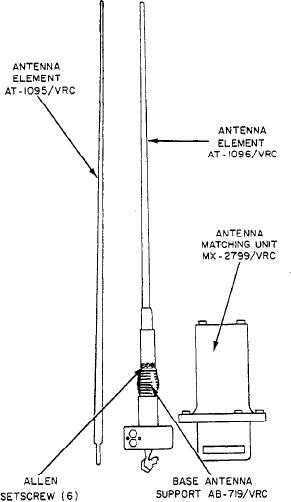
heavy gloves. Unlike older, similar radio sets, there are
no front-panel meters or indicator lights on the
AN/PRC-104. The functions that formerly required
these types of indicators (antenna tuning, battery
condition, etc.) are monitored by the radio itself and
communicated to the operator as special tones in the
handset. This feature is particularly useful during
tactical black-out operations. The superior design and
innovative features of the AN/PRC-104 radio set now
make it possible to maintain a reliable long-range
communications link using lightweight, portable
equipment that can be operated by personnel with a
minimum amount of training.
RADIO SET.-- The AN/PRC-104 radio set consists
of three units: (fig. 11-7) low-power receiver-
transmitter RT-1209/URC (receiver/exciter), 20-watt
radio frequency amplifier AM-6874/PRC-104
(amplifier/coupler), and battery case CY-7541/
PRC-104 (battery pack). Quick-disconnect latches
secure the receiver/exciter to the amplifier/coupler, and
each is latched to one end of the battery pack When
latched together, the receiver/exciter is electrically
interconnected with the amplifier/coupler through a
built-in connector; the battery pack power is connected
to the amplifier/coupler. All of the operator controls and
connections are located on the receiver/exciter front
panel, except for the antenna select switch and antenna
Figure 11-4D.--Antenna AT-912/URC for Radio Set AN/
GRC-160.
connections located on the amplifier/coupler unit. They
are constructed on a die-cast aluminum housing; the
battery pack housing is tough plastic. Watertight seals
AN/PRC-104 Radio Transceiver
for the covers and panels make the three units watertight,
submersible, and capable of rough handling and abuse
The AN/PRC-104 (fig. 11-5A, 11-5B, and 11-5C)
in any field environment. The unit circuits are modular
is a state-of-the-art lightweight radio transceiver
for ease of repair. The total weight of the assembled
(transmitter and receiver combined) that operates in the
AN/PRC-104 (three units with battery) is 14 pounds,
high frequency (hf) and upper part of the low frequency
making it a lightweight and easily carried package.
(lf) portions of the radio spectrum. The receiver/
MAN-PACK OPERATION.-- The basic man-pack
transmitter circuits can be tuned to any frequency
configuration (fig. 11-8) consists of the radio set (three
between 2.0000 and 29.9999 MHz in 100 Hz
units), a whip antenna, and an audio input/output device.
increments, making it possible to tune up to 280,000
Antenna AT-217A/PRC is a 10-foot standard whip
separate frequencies. The radio set operates in the upper
antenna that screws into the Spring Section Antenna
sideband (USB) or lower sideband (LSB) modes for
AB-129/PR (shock mount) which, in turn, screws into
voice communications, CW for morse code, or
the antenna mount on the amplifier/coupler. The whip
frequency shift keying (FSK) for transmission of
antenna is adequate for most short-range requirements
teletype signals or other data. In the man-pack
(less then 10 miles). Two standard input/output devices
configuration the radio set is designed to be carried and
come with the radio set: Handset H-189/GR and
operated by one manor, with the proper accessories, the
Telegraph Key KY-872/PRC-104. These are attached to
radio set can be configured for vehicular or fixed-station
either of the two AUDIO connectors on the receiver/
use.
exciter. The radio transmitter (exciter) is enabled
The control panel (fig. 11-6) was engineered for
(keyed) by the handset push-to-talk (PTT) button or by
ease of operation by making it possible for the operator
depressing the telegraph key to contact. The receiver is
to adjust the front panel controlseven while wearing
operative only when the transmitter is disabled;
11-6

